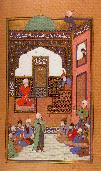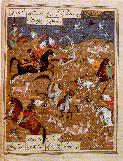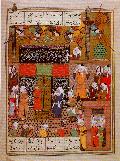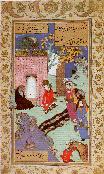Miniatures
VI- The Uzbeks and the Safavids
The Uzbek occupation of Herat in 1506-7 under Muhammad Shaybani
inaugurated a period of instability in Khurasan. Herat did not, however,
lose its pre-eminence in the arts of the book, but the principal
Herati painters gradually dispersed towards Tashkent, Bukhara and Tabriz.
Much Bukhara painting of the mid-sixteenth century is in the style of
Bihzad school, albeit with simplification of architectural detail, a narrower
range of brilliant colours and, ultimately, figure painting lacking in
realism and vivacity. The Safavids occupied Tabriz in 1501 and their
leader Ismail had himself crowned Shah of Iran. Their art was inspired
by nationalistic sentiments as well as Turcoman painters of the Akkoyunlu
studio. The successor of Ismail, Shah Tahmasp worked on a great illuminated
Khamsa of Nizami, written by calligrapher Shah Mahmud al-Naysaburi. The other
fine manuscript, Shahname, had dispersed after it was presented to the
Ottoman Sultan Selim II in 1567. The depicted illustrations are from Khamsa
of Nizami.

|
Scene in the Great Mosque at Delhi
Qiran al-Sa'dayn.
Safavid Tabriz, 1516.
Hazine 871, folio 19b
|

|
Khusraw hunting
Nizami, Khamsa.
Safavid Shiraz, 1534.
Hazine 760, folio 90b
|

|
Iskandar at the Ka'ba
Nizami, Khamsa.
Safavid Shiraz, 1534.
Hazine 760, folio 304bb
|

|
Visit to a dervish
Makhzan al-Asrar.
Safavid Isfahan, 1610.
Hazine 1641, folio 26a
|



